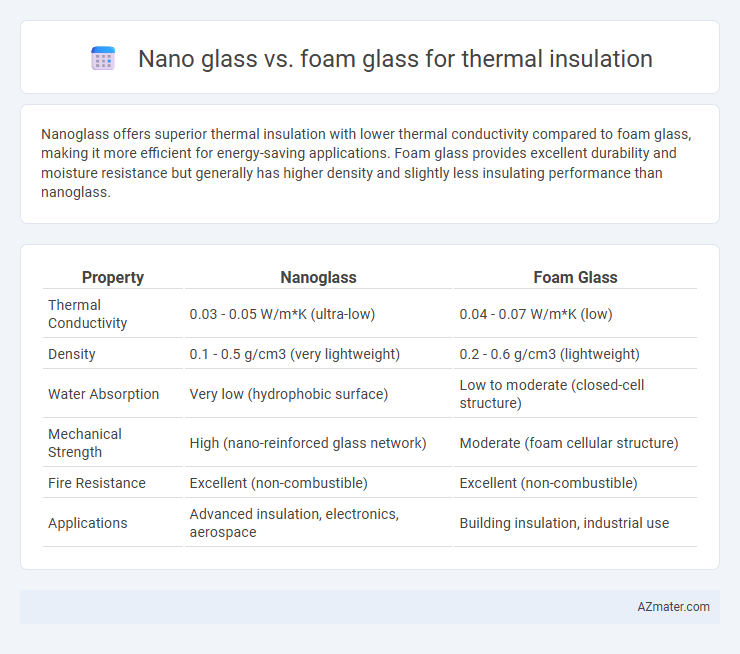Nanoglass offers superior thermal insulation with lower thermal conductivity compared to foam glass, making it more efficient for energy-saving applications. Foam glass provides excellent durability and moisture resistance but generally has higher density and slightly less insulating performance than nanoglass.
Table of Comparison
| Property | Nanoglass | Foam Glass |
|---|---|---|
| Thermal Conductivity | 0.03 - 0.05 W/m*K (ultra-low) | 0.04 - 0.07 W/m*K (low) |
| Density | 0.1 - 0.5 g/cm3 (very lightweight) | 0.2 - 0.6 g/cm3 (lightweight) |
| Water Absorption | Very low (hydrophobic surface) | Low to moderate (closed-cell structure) |
| Mechanical Strength | High (nano-reinforced glass network) | Moderate (foam cellular structure) |
| Fire Resistance | Excellent (non-combustible) | Excellent (non-combustible) |
| Applications | Advanced insulation, electronics, aerospace | Building insulation, industrial use |
Introduction to Thermal Insulation Materials
Nanoglass and foam glass are advanced thermal insulation materials used to reduce heat transfer in various applications. Nanoglass offers superior thermal resistance due to nanoscale pore structures, enhancing energy efficiency in building envelopes and industrial systems. Foam glass, composed of recycled glass with closed-cell foam structure, provides excellent thermal insulation combined with high compressive strength and moisture resistance.
What is Nanoglass?
Nanoglass is an advanced insulation material composed of ultra-fine glass particles with nanoscale porosity, providing exceptional thermal resistance by trapping air within its fine structure. Unlike foam glass, which contains larger, closed-cell bubbles for insulation, nanoglass offers superior energy efficiency due to its higher surface area and lower thermal conductivity. Its nanoscale pore distribution enhances durability, moisture resistance, and fireproof properties, making it ideal for high-performance thermal insulation applications.
What is Foam Glass?
Foam glass is a highly durable, lightweight thermal insulation material composed of crushed glass that is heated and foamed to create a network of airtight pockets. Its cellular structure provides excellent compressive strength, fire resistance, and moisture resistance, making it ideal for industrial and construction applications. Unlike nanoglass, foam glass offers superior rigidity and is often used in environments requiring both insulation and structural support.
Key Properties of Nanoglass
Nanoglass demonstrates superior thermal insulation efficiency compared to foam glass due to its ultra-fine nanostructure, which minimizes heat conduction through densely packed nanoparticles. Its high porosity combined with nanoscale pore sizes significantly reduces thermal conductivity while maintaining excellent mechanical strength and durability. Nanoglass also offers enhanced resistance to moisture and fire, making it an ideal material for advanced thermal insulation applications in construction and industrial settings.
Key Properties of Foam Glass
Foam glass offers exceptional thermal insulation due to its closed-cell structure, providing low thermal conductivity typically around 0.05 W/m*K, outstanding compressive strength of up to 3 MPa, and excellent moisture resistance. Its fireproof and chemically inert properties make it highly durable and suitable for harsh environments. Compared to nanoglass, foam glass excels in mechanical robustness and long-term stability in insulation applications.
Thermal Performance: Nanoglass vs Foam Glass
Nanoglass exhibits superior thermal performance compared to foam glass due to its nanoscale pore structure that significantly reduces heat transfer and enhances insulation efficiency. Foam glass, while effective, has larger pores which result in higher thermal conductivity and slightly lower insulating properties. The advanced nanostructure of nanoglass allows for lower thermal conductivity values, typically ranging between 0.02 to 0.03 W/m*K, outperforming foam glass which generally ranges from 0.04 to 0.06 W/m*K.
Durability and Longevity Comparison
Nanoglass offers superior durability compared to foam glass due to its denser microstructure and enhanced resistance to moisture and thermal cycling. Foam glass, while effective as a thermal insulator, tends to be more brittle and susceptible to cracking over time under mechanical stress. Nanoglass's longevity is significantly higher, making it a preferred choice for applications requiring long-term thermal insulation performance in harsh environments.
Environmental Impact and Sustainability
Nanoglass offers superior thermal insulation with a lower density and enhanced recyclability compared to foam glass, reducing material waste and energy consumption during production. Foam glass, made from recycled glass cullet, provides excellent fire resistance and durability but typically involves higher energy usage in manufacturing, contributing to a larger carbon footprint. Both materials support sustainability, yet nanoglass's advanced fabrication processes and reduced resource intensity position it as a more environmentally sustainable thermal insulation option.
Application Areas and Use Cases
Nanoglass offers superior thermal insulation performance in electronics, aerospace, and advanced roofing systems, where space constraints demand thin, high-efficiency materials. Foam glass finds widespread use in industrial pipelines, cryogenic tanks, and building foundations due to its durability, moisture resistance, and fire retardant properties. Both materials excel in insulating applications but are chosen based on specific thermal resistance requirements and environmental conditions.
Cost Comparison and Final Recommendations
Nanoglass insulation typically demonstrates higher upfront costs compared to foam glass due to advanced manufacturing processes and superior thermal conductivity benefits. Foam glass offers a more cost-effective solution with competitive thermal resistance and excellent durability under moisture exposure, making it suitable for budget-sensitive projects. For optimal thermal insulation performance combined with cost-efficiency, foam glass is recommended for standard applications, while nanoglass is preferable for high-performance, energy-saving constructions where long-term savings justify higher initial investment.

Infographic: Nanoglass vs Foam glass for Thermal insulation
 azmater.com
azmater.com